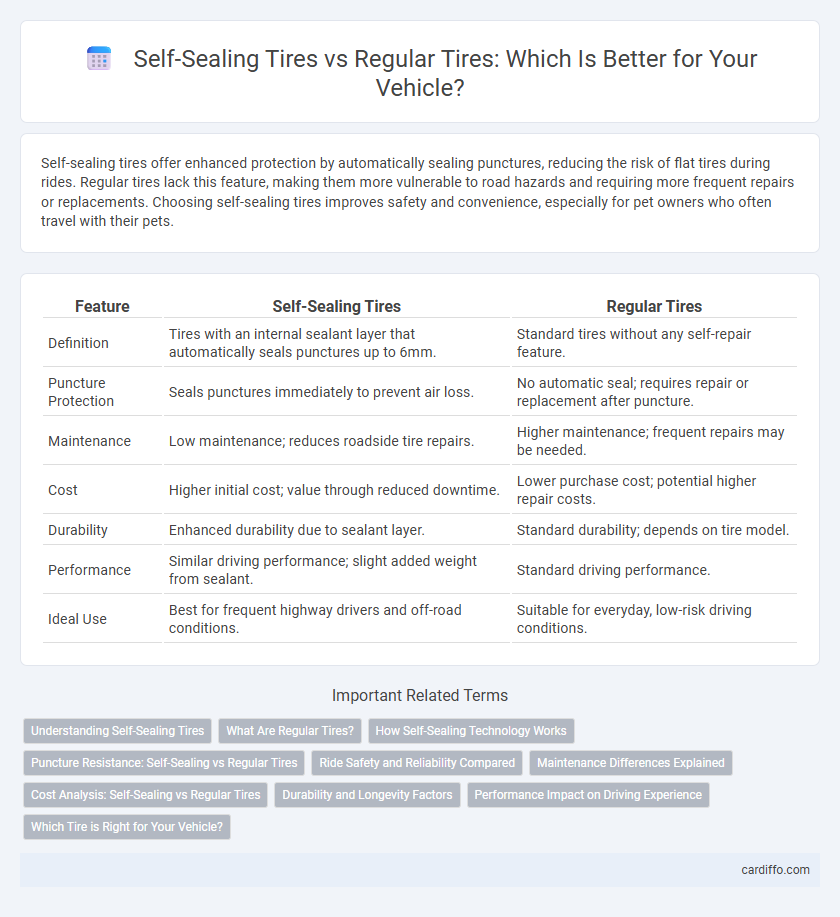Self-sealing tires offer enhanced protection by automatically sealing punctures, reducing the risk of flat tires during rides. Regular tires lack this feature, making them more vulnerable to road hazards and requiring more frequent repairs or replacements. Choosing self-sealing tires improves safety and convenience, especially for pet owners who often travel with their pets.
Table of Comparison
| Feature | Self-Sealing Tires | Regular Tires |
|---|---|---|
| Definition | Tires with an internal sealant layer that automatically seals punctures up to 6mm. | Standard tires without any self-repair feature. |
| Puncture Protection | Seals punctures immediately to prevent air loss. | No automatic seal; requires repair or replacement after puncture. |
| Maintenance | Low maintenance; reduces roadside tire repairs. | Higher maintenance; frequent repairs may be needed. |
| Cost | Higher initial cost; value through reduced downtime. | Lower purchase cost; potential higher repair costs. |
| Durability | Enhanced durability due to sealant layer. | Standard durability; depends on tire model. |
| Performance | Similar driving performance; slight added weight from sealant. | Standard driving performance. |
| Ideal Use | Best for frequent highway drivers and off-road conditions. | Suitable for everyday, low-risk driving conditions. |
Understanding Self-Sealing Tires
Self-sealing tires contain an inner lining coated with a sealant gel that automatically fills punctures up to 6mm, preventing air loss without the need for immediate repair. This technology enhances tire durability and ensures continuous safety during driving, reducing downtime compared to regular tires. Unlike traditional tires, which require prompt patching or replacement after punctures, self-sealing tires provide enhanced convenience and reliability for everyday use.
What Are Regular Tires?
Regular tires are standard vehicle tires without any internal sealing technology, designed to maintain air pressure under normal driving conditions. They rely on the tire's structural integrity and the vehicle's maintenance to prevent air loss and require external repair if punctured. Unlike self-sealing tires, regular tires do not automatically seal punctures, increasing the risk of rapid air loss and potential tire failure.
How Self-Sealing Technology Works
Self-sealing tires feature an inner lining coated with a layer of sealant that instantly reacts to punctures by filling holes up to 5 millimeters in diameter, preventing air loss and maintaining tire pressure. This innovative technology relies on a viscous latex-based compound that seals punctures within seconds, enhancing safety and reducing downtime. In contrast, regular tires lack this self-repair capability and require immediate manual repair or replacement when punctured.
Puncture Resistance: Self-Sealing vs Regular Tires
Self-sealing tires feature an inner lining infused with a sealant that automatically fills punctures up to 6mm, significantly reducing the risk of air loss and flat tires compared to regular tires. Regular tires lack this built-in technology, making them more susceptible to punctures and requiring immediate repair or replacement when damaged. The enhanced puncture resistance of self-sealing tires improves vehicle safety and minimizes downtime, making them ideal for off-road and urban driving conditions prone to debris.
Ride Safety and Reliability Compared
Self-sealing tires enhance ride safety by automatically sealing punctures up to 5mm, reducing the risk of sudden air loss and tire blowouts compared to regular tires. Their reliability in maintaining consistent tire pressure improves vehicle control and stability, especially on long trips or rugged terrain. Regular tires, lacking this self-sealing feature, require immediate repair or replacement after punctures, potentially compromising safety and reliability during critical moments.
Maintenance Differences Explained
Self-sealing tires feature an internal sealant layer that automatically seals punctures up to a certain size, significantly reducing the need for frequent tire repairs and pressure maintenance compared to regular tires. Regular tires require periodic inspections for potential leaks, frequent pressure checks, and prompt patching or replacement when punctured. The self-sealing technology enhances durability and decreases downtime caused by flat tires, offering a more convenient and lower-maintenance solution for drivers.
Cost Analysis: Self-Sealing vs Regular Tires
Self-sealing tires generally have a higher upfront cost, often priced 20-30% more than regular tires due to their specialized sealing layers designed to prevent punctures. Over time, the reduced need for repairs and replacements can lower overall maintenance expenses, potentially offsetting the initial investment. Regular tires may incur higher long-term costs related to frequent patching, tire changes, and downtime caused by flat tires.
Durability and Longevity Factors
Self-sealing tires feature an inner lining coated with a sealant that automatically plugs punctures, significantly enhancing durability by preventing air loss and tire damage during regular use. In contrast, regular tires lack this self-repair capability, often requiring immediate repair or replacement after punctures, which can reduce their overall lifespan and reliability. Factors such as road conditions, driving habits, and tire maintenance also affect longevity, but self-sealing tires generally offer improved resilience and extended usability compared to standard tires.
Performance Impact on Driving Experience
Self-sealing tires enhance driving safety by automatically sealing punctures up to 5mm, maintaining consistent tire pressure and improving handling stability on various road conditions. Regular tires may offer slightly better fuel efficiency and ride comfort due to lighter construction but risk sudden air loss, compromising vehicle control and increasing stop distances. The trade-off between puncture resistance and subtle performance variations influences overall driving confidence and safety in different environments.
Which Tire is Right for Your Vehicle?
Self-sealing tires contain a special inner lining that automatically seals small punctures up to 6mm, reducing the risk of sudden flats and enhancing convenience for daily driving. Regular tires, while generally more affordable and widely available, require immediate repair or replacement after punctures, impacting safety and vehicle performance. Choosing the right tire depends on driving habits, road conditions, and budget, with self-sealing tires being ideal for urban environments prone to debris and regular tires suited for occasional, cost-conscious use.
Self-sealing tires vs Regular tires Infographic

 cardiffo.com
cardiffo.com